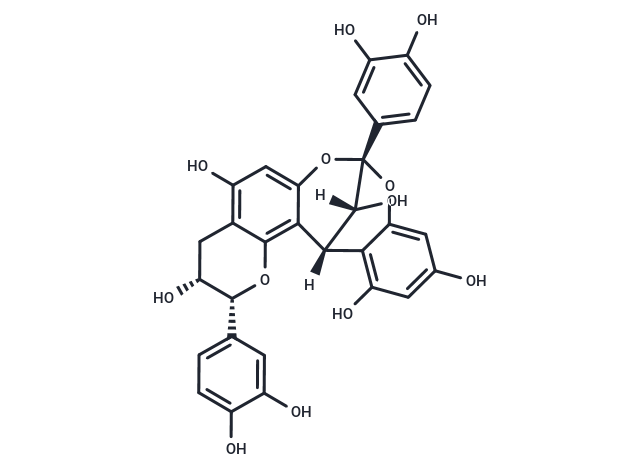Shopping Cart
Remove All Your shopping cart is currently empty
Your shopping cart is currently empty
Procyanidin A2 is a potential precursor of 5-(3',4'-dihydroxyphenyl)-γ-valerolactone, exhibits antioxidant, anti-inflammary, anti-hyperglycemia, and anti-type 2 diabetes activities. Procyanidin A2 demonstrates liver cell regenerative activity in scratch wound healing assays and alcohol-induced liver cell injury in vitro.

| Pack Size | Price | USA Warehouse | Global Warehouse | Quantity |
|---|---|---|---|---|
| 1 mg | $80 | In Stock | In Stock | |
| 5 mg | $247 | In Stock | In Stock | |
| 10 mg | $369 | In Stock | In Stock | |
| 25 mg | $615 | In Stock | In Stock | |
| 50 mg | $869 | - | In Stock | |
| 100 mg | $1,170 | - | In Stock | |
| 1 mL x 10 mM (in DMSO) | $313 | In Stock | In Stock |
| Description | Procyanidin A2 is a potential precursor of 5-(3',4'-dihydroxyphenyl)-γ-valerolactone, exhibits antioxidant, anti-inflammary, anti-hyperglycemia, and anti-type 2 diabetes activities. Procyanidin A2 demonstrates liver cell regenerative activity in scratch wound healing assays and alcohol-induced liver cell injury in vitro. |
| In vitro | Here we evaluated Procyanidin A2 as a means of modulating CCL26 production and investigated interactions with the known inflammation modulator, Interferon γ (IFNγ). We used the human lung epithelial cell line A549 and optimized the conditions for inducing CCL26. Cells were exposed to a range of Procyanidin A2 or IFNγ concentrations for varied lengths of time prior to an inflammatory insult of interleukin-4 (IL-4) for 24 h. An enzyme-linked immunosorbent assay was used to measure CCL26 production. Exposing cells to 5 μM Procyanidin A2 (prior to IL-4) reduced CCL26 production by 35% compared with control. Greatest inhibition by Procyanidin A2 was seen with a 2 h exposure prior to IL-4, whereas IFNγ inhibition was greatest at 24 h. Concomitant incubation of Procyanidin A2 and IFNγ did not extend the inhibitory efficacy of Procyanidin A2[1] |
| Molecular Weight | 576.5 |
| Formula | C30H24O12 |
| Cas No. | 41743-41-3 |
| Smiles | [H][C@@]1(O)[C@]2([H])c3c(O)cc(O)cc3O[C@]1(Oc1cc(O)c3C[C@@H](O)[C@H](Oc3c21)c1ccc(O)c(O)c1)c1ccc(O)c(O)c1 |
| Relative Density. | 1.766g/cm3 |
| Color | White |
| Appearance | Solid |
| Storage | store at low temperature | Powder: -20°C for 3 years | In solvent: -80°C for 1 year | Shipping with blue ice/Shipping at ambient temperature. | |||||||||||||||||||||||||||||||||||
| Solubility Information | DMSO: 100 mg/mL (173.46 mM), Sonication is recommended. | |||||||||||||||||||||||||||||||||||
| In Vivo Formulation | 10% DMSO+40% PEG300+5% Tween 80+45% Saline: 4 mg/mL (6.94 mM), Sonication is recommended. Please add the solvents sequentially, clarifying the solution as much as possible before adding the next one. Dissolve by heating and/or sonication if necessary. Working solution is recommended to be prepared and used immediately. The formulation provided above is for reference purposes only. In vivo formulations may vary and should be modified based on specific experimental conditions. | |||||||||||||||||||||||||||||||||||
Solution Preparation Table | ||||||||||||||||||||||||||||||||||||
DMSO
| ||||||||||||||||||||||||||||||||||||
| Size | Quantity | Unit Price | Amount | Operation |
|---|

Copyright © 2015-2025 TargetMol Chemicals Inc. All Rights Reserved.